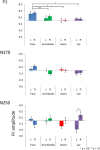Brain Activity Related to the Judgment of Face-Likeness: Correlation between EEG and Face-Like Evaluation
- PMID: 29503612
- PMCID: PMC5820434
- DOI: 10.3389/fnhum.2018.00056
Brain Activity Related to the Judgment of Face-Likeness: Correlation between EEG and Face-Like Evaluation
Abstract
Faces represent important information for social communication, because social information, such as face-color, expression, and gender, is obtained from faces. Therefore, individuals' tend to find faces unconsciously, even in objects. Why is face-likeness perceived in non-face objects? Previous event-related potential (ERP) studies showed that the P1 component (early visual processing), the N170 component (face detection), and the N250 component (personal detection) reflect the neural processing of faces. Inverted faces were reported to enhance the amplitude and delay the latency of P1 and N170. To investigate face-likeness processing in the brain, we explored the face-related components of the ERP through a face-like evaluation task using natural faces, cars, insects, and Arcimboldo paintings presented upright or inverted. We found a significant correlation between the inversion effect index and face-like scores in P1 in both hemispheres and in N170 in the right hemisphere. These results suggest that judgment of face-likeness occurs in a relatively early stage of face processing.
Keywords: ERP/EEG; face inversion effect; face perception; face-like patterns; pareidolia.
Figures






Similar articles
-
Early holistic face-like processing of Arcimboldo paintings in the right occipito-temporal cortex: evidence from the N170 ERP component.Int J Psychophysiol. 2013 Nov;90(2):157-64. doi: 10.1016/j.ijpsycho.2013.06.024. Epub 2013 Jun 29. Int J Psychophysiol. 2013. PMID: 23816562
-
Early lateralization and orientation tuning for face, word, and object processing in the visual cortex.Neuroimage. 2003 Nov;20(3):1609-24. doi: 10.1016/j.neuroimage.2003.07.010. Neuroimage. 2003. PMID: 14642472 Clinical Trial.
-
The effects of facial color and inversion on the N170 event-related potential (ERP) component.Neuroscience. 2015 Dec 17;311:341-8. doi: 10.1016/j.neuroscience.2015.10.019. Epub 2015 Oct 23. Neuroscience. 2015. PMID: 26477984
-
The faces of development: a review of early face processing over childhood.J Cogn Neurosci. 2004 Oct;16(8):1426-42. doi: 10.1162/0898929042304732. J Cogn Neurosci. 2004. PMID: 15509388 Review.
-
Fusing concurrent EEG-fMRI with dynamic causal modeling: application to effective connectivity during face perception.Neuroimage. 2014 Nov 15;102 Pt 1:60-70. doi: 10.1016/j.neuroimage.2013.06.083. Epub 2013 Jul 9. Neuroimage. 2014. PMID: 23850464 Review.
Cited by
-
Face pareidolia in male schizophrenia.Schizophrenia (Heidelb). 2022 Dec 14;8(1):112. doi: 10.1038/s41537-022-00315-y. Schizophrenia (Heidelb). 2022. PMID: 36517504 Free PMC article.
-
Human-like face pareidolia emerges in deep neural networks optimized for face and object recognition.PLoS Comput Biol. 2025 Jan 27;21(1):e1012751. doi: 10.1371/journal.pcbi.1012751. eCollection 2025 Jan. PLoS Comput Biol. 2025. PMID: 39869654 Free PMC article.
-
Face and face pareidolia in patients with temporal lobe epilepsy indicates different neural processing: an event-related potential study.Acta Epileptol. 2024 Oct 9;6(1):34. doi: 10.1186/s42494-024-00175-2. Acta Epileptol. 2024. PMID: 40217362 Free PMC article.
-
Facial ambiguity and perception: How face-likeness affects breaking time in continuous flash suppression.J Vis. 2024 Sep 3;24(9):18. doi: 10.1167/jov.24.9.18. J Vis. 2024. PMID: 39330994 Free PMC article.
-
Do subtle cultural differences sculpt face pareidolia?Schizophrenia (Heidelb). 2023 May 4;9(1):28. doi: 10.1038/s41537-023-00355-y. Schizophrenia (Heidelb). 2023. PMID: 37142598 Free PMC article.
References
LinkOut - more resources
Full Text Sources
Other Literature Sources

